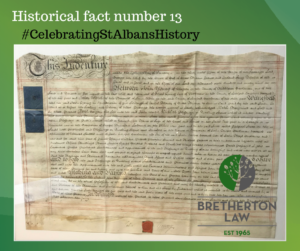 The 5th of August marks the centenary of the last Zeppelin airship raid over Britain in the First World War. During the course of the war there were 51 airship raids in which bombs were dropped – sometimes referred to as the first Blitz. South Hertfordshire was the backdrop for many of these raids, as the circular route from their bases in northern Germany brought the Zeppelins across East Anglia and Essex, before they would turn over London to drop their bombs. Inevitably, bad weather and rudimentary navigational aids resulted in many Zeppelin captains dropping their bombs away from their intended targets in the capital.
The 5th of August marks the centenary of the last Zeppelin airship raid over Britain in the First World War. During the course of the war there were 51 airship raids in which bombs were dropped – sometimes referred to as the first Blitz. South Hertfordshire was the backdrop for many of these raids, as the circular route from their bases in northern Germany brought the Zeppelins across East Anglia and Essex, before they would turn over London to drop their bombs. Inevitably, bad weather and rudimentary navigational aids resulted in many Zeppelin captains dropping their bombs away from their intended targets in the capital.
Cheshunt had been attacked in 1915, and there were other raids on the villages of Willian and Essendon before the most serious attack occurred over Hertford in October, 1916. Forty eight bombs hit the town, destroying buildings in North Street. Nine people were killed and 15 injured, with several people falling victim as they came out of their homes to watch the Zeppelins overhead.
Several of the raids in 1916 were in retaliation for a famous incident which occurred over Cuffley in south Hertfordshire, in which an airship was shot down over Britain for the first time. The pilot of the British B.E.2c fighter plane, Lieutenant William Leefe Robinson, became the first person to receive a Victoria Cross for an action in the UK, and he became an overnight celebrity as news of his success spread.
The airship in question, a Schutte-Lanz SL 11, was one of 16 involved in a raid on the night of 2/3 September, 1916. This was the largest raid of the war, and resulted in the dropping of over 500 bombs. Airship SL11 arrived near St Albans at 1.10am and dropped three explosive and three incendiary bombs in fields near London Colney and South Mimms, before taking part in more raids over North London. Flying from his base near Hornchurch, Robinson intercepted airship SL11 near Enfield and brought the machine down at the third attempt with incendiary bullets. The airship crashed into a field behind the Plough Inn, Cuffley, and Captain Schramm and all 15 of his crew were killed.
Many thousands of people travelled to Cuffley to see the crashed airship, and fragments were collected and sold by the Red Cross in aid of wounded soldiers. Within an unprecedented two days Robinson had been awarded the Victoria Cross, receiving his medal at Windsor Castle on 9th September. He was also awarded £3,500 in prize money, and a silver cup from the people of Hornchurch.
As a national celebrity Robinson was too valuable to be allowed to carry on flying, especially after crashing his plane on take-off only a week after receiving his V.C. and narrowly escaping death. However, after much pestering of the authorities he was returned to active service in France in April, 1917. His comeback was short-lived, however, and he was shot down and captured on his first patrol over enemy lines. Sadly, after being repatriated in early December, 1918, Robinson contracted Spanish flu and died on 31st December in Stanmore, aged just 23. Thousands of onlookers lined to route to his burial at All Saints’ Church, Harrow Weald.
A memorial to William Leefe Robinson was later erected near the site of crashed airship SL11. And more recently a restaurant in the Miller and Carter chain near the cemetery was named the Leefe Robinson VC in his memory. If you ever dine there, perhaps you should raise your glass to honour a brave defender of Britain’s skies.
This article is part of our Celebrating St Albans History series. You can view all our historical facts on our Celebrating St Albans History page. If you have a historical fact you would like to add please let us know by using the contact form below or by emailing info@brethertonlaw.co.uk




